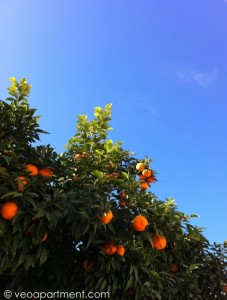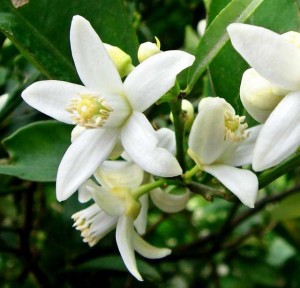 One of the first things many visitors to Seville notice is the orange trees. They line many of the streets and squares, more of them than any other type of tree in Seville, enough to make the city one of the most densely wooded parts of Spain. From autumn to around the end of January, when they are harvested, they are laden with fruit of an almost startling orange, but before that the fruit are a greenish colour, and can be mistaken for limes.
One of the first things many visitors to Seville notice is the orange trees. They line many of the streets and squares, more of them than any other type of tree in Seville, enough to make the city one of the most densely wooded parts of Spain. From autumn to around the end of January, when they are harvested, they are laden with fruit of an almost startling orange, but before that the fruit are a greenish colour, and can be mistaken for limes.
The trees are actually a variety of bitter orange, scientific name citrus x aurentium, and despite being everywhere in Seville, they are not, in fact, native to Spain, but to south-east Asia, and were brought here by the Arabs in the 12th century. Although sweet oranges are grown in other places in Spain, for the city streets the Moorish rulers preferred bitter oranges, as people wouldn’t pick them to eat, and the trees would retain their decorative aspect.
 The trees blossom in early spring, producing delicate white flowers called azahar, a name derived from the Arabic for “white flower”, and for two or three weeks their distinctive scent fills the air, and is an important part of the “spring experience” in Seville. Extracts of the azahar are used for perfumes and scented water, and have a mild tranquilising effect.
The trees blossom in early spring, producing delicate white flowers called azahar, a name derived from the Arabic for “white flower”, and for two or three weeks their distinctive scent fills the air, and is an important part of the “spring experience” in Seville. Extracts of the azahar are used for perfumes and scented water, and have a mild tranquilising effect.
Strangely enough, the Spanish make very little use of the fruit themselves. After harvesting, most of the fruit is shipped off to – where else? – England, where it is used to make that very traditional English breakfast food, Oxford marmalade. Seville oranges are widely considered to be the best in the world for this purpose, because the high natural pectin content helps the marmalade to set correctly. It is also said, though I can’t vouch for it personally, that the oranges from the Patio de Banderas next to the Alcázar Palace, are sent as a gift from the King of Spain to the Queen of England for making her own special marmalade.
If you want to try your hand at making your own marmalade while the oranges are in season, this is an easy Orange Marmalade Recipe from the BBC’s good food guide.
Pingback: Seville | Five Centenarian bars | veoapartment
Pingback: Seville | Everything you always wanted to know about oranges... | veoapartment